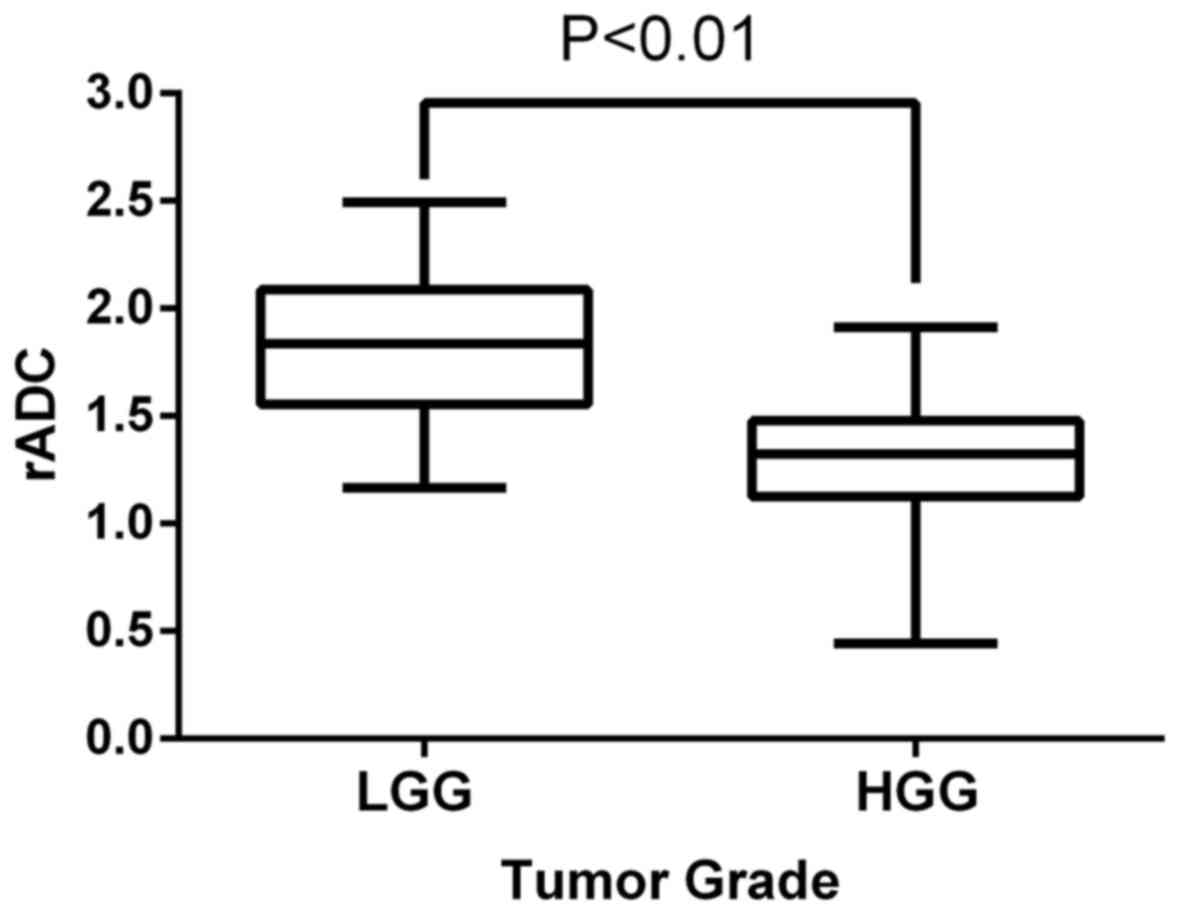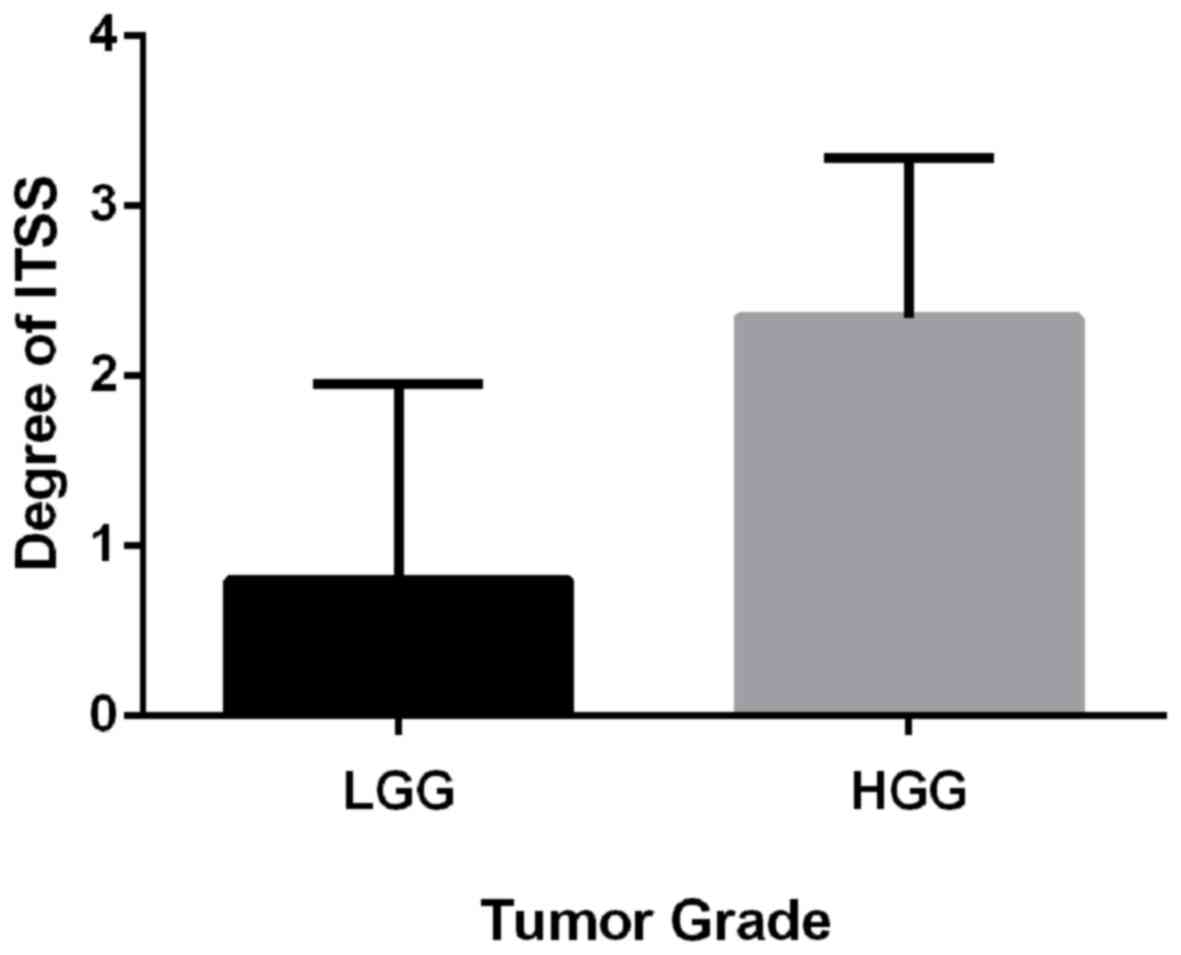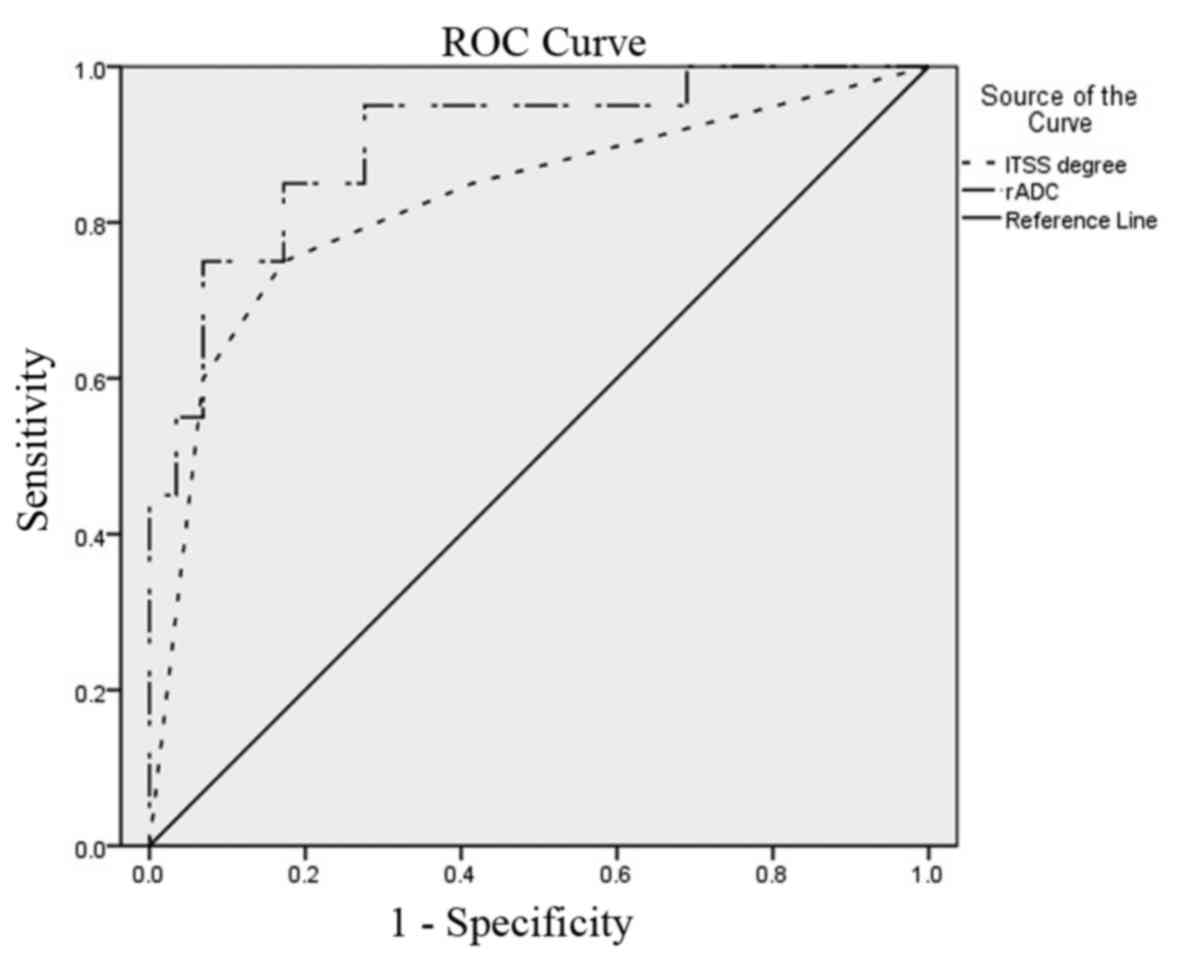|
1
|
Inoue T, Ogasawara K, Beppu T, Ogawa A and
Kabasawa H: Diffusion tensor imaging for preoperative evaluation of
tumor grade in gliomas. Clin Neurol Neurosurg. 107:174–180. 2005.
View Article : Google Scholar : PubMed/NCBI
|
|
2
|
Yoon JH, Kim JH, Kang WJ, Sohn CH, Choi
SH, Yun TJ, Eun Y, Song YS and Chang KH: Grading of cerebral glioma
with multiparametric MR imaging and 18F-FDG-PET. Concordance and
Accuracy. Eur Radiol. 24:380–389. 2014. View Article : Google Scholar : PubMed/NCBI
|
|
3
|
Van Cauter S, De Keyzer F, Sima DM, Sava
AC, D'Arco F, Veraart J, Peeters RR, Leemans A, Van Gool S, Wilms
G, et al: Integrating diffusion kurtosis imaging, dynamic
susceptibility-weighted contrast-enhanced MRI, and short echo time
chemical shift imaging for grading gliomas. Neuro Oncol.
16:1010–1021. 2014. View Article : Google Scholar : PubMed/NCBI
|
|
4
|
Guo AC, Cummings TJ, Dash RC and
Provenzale JM: Lymphomas and high-grade astrocytomas: Comparison of
water diffusibility and histologic characteristics. Radiology.
224:177–183. 2002. View Article : Google Scholar : PubMed/NCBI
|
|
5
|
Sugahara T, Korogi Y, Kochi M, Ikushima I,
Shigematu Y, Hirai T, Okuda T, Liang L, Ge Y, Komohara Y, et al:
Usefulness of diffusion-weighted MRI with echo-planar technique in
the evaluation of cellularity in gliomas. J Magn Reson Imaging.
9:53–60. 1999. View Article : Google Scholar : PubMed/NCBI
|
|
6
|
Higano S, Yun X, Kumabe T, Watanabe M,
Mugikura S, Umetsu A, Sato A, Yamada T and Takahashi S: Malignant
astrocytic tumors: Clinical importance of apparent diffusion
coefficient in prediction of grade and prognosis. Radiology.
241:839–846. 2006. View Article : Google Scholar : PubMed/NCBI
|
|
7
|
Bulakbasi N, Guvenc I, Onguru O, Erdogan
E, Tayfun C and Ucoz T: The added value of the apparent diffusion
coefficient calculation to magnetic resonance imaging in the
differentiation and grading of malignant brain tumors. J Comput
Assist Tomogr. 28:735–746. 2004. View Article : Google Scholar : PubMed/NCBI
|
|
8
|
Kono K, Inoue Y, Nakayama K, Shakudo M,
Morino M, Ohata K, Wakasa K and Yamada R: The role of
diffusion-weighted imaging in patients with brain tumors. AJNR Am J
Neuroradiol. 22:1081–1088. 2001.PubMed/NCBI
|
|
9
|
Lam WW, Poon WS and Metreweli C: Diffusion
MR imaging in glioma: Does it have any role in the pre-operation
determination of grading of glioma? Clin Radiol. 57:219–225. 2002.
View Article : Google Scholar : PubMed/NCBI
|
|
10
|
Arvinda HR, Kesavadas C, Sarma PS, Thomas
B, Radhakrishnan VV, Gupta AK, Kapilamoorthy TR and Nair S: Glioma
grading: Sensitivity, specificity, positive and negative predictive
values of diffusion and perfusion imaging. J NeuroOncol. 94:87–96.
2009. View Article : Google Scholar : PubMed/NCBI
|
|
11
|
Sehgal V, Delproposto Z, Haacke EM, Tong
KA, Wycliffe N, Kido DK, Xu Y, Neelavalli J, Haddar D and
Reichenbach JR: Clinical applications of neuroimaging with
susceptibility-weighted imaging. J Magn Reson Imaging. 22:439–450.
2005. View Article : Google Scholar : PubMed/NCBI
|
|
12
|
Wang XC, Zhang H, Tan Y, Qin JB, Wu XF,
Wang L and Zhang L: Combined value of susceptibility-weighted and
perfusion-weighted imaging in assessing WHO grade for brain
astrocytomas. J Magn Reson Imaging. 39:1569–1574. 2014. View Article : Google Scholar : PubMed/NCBI
|
|
13
|
Di Ieva A, Göd S, Grabner G, Grizzi F,
Sherif C, Matula C, Tschabitscher M and Trattnig S:
Three-dimensional susceptibility-weighted imaging at 7 T using
fractal-based quantitative analysis to grade gliomas.
Neuroradiology. 55:35–40. 2013. View Article : Google Scholar : PubMed/NCBI
|
|
14
|
Hori M, Mori H, Aoki S, Abe O, Masumoto T,
Kunimatsu S, Ohtomo K, Kabasawa H, Shiraga N and Araki T:
Three-dimensional susceptibility-weighted imaging at 3 T using
various image analysis methods in the estimation of grading
intracranial gliomas. Magn Reson Imaging. 28:594–598. 2010.
View Article : Google Scholar : PubMed/NCBI
|
|
15
|
Pinker K, Noebauer-Huhmann IM, Stavrou I,
Hoeftberger R, Szomolanyi P, Karanikas G, Weber M, Stadlbauer A,
Knosp E, Friedrich K and Trattnig S: High-resolution
contrast-enhanced, susceptibility-weighted MR imaging at 3T in
patients with brain tumors. correlation with positron-emission
tomography and histopathologic findings. AJNR Am J Neuroradiol.
28:1280–1286. 2007. View Article : Google Scholar : PubMed/NCBI
|
|
16
|
Heiss WD, Raab P and Lanfermann H:
Multimodality assessment of brain tumors and tumor recurrence. J
Nucl Med. 52:1585–1600. 2011. View Article : Google Scholar : PubMed/NCBI
|
|
17
|
Furtner J, Schöpf V, Preusser M, Asenbaum
U, Woitek R, Wöhrer A, Hainfellner JA, Wolfsberger S and Prayer D:
Non-invasive assessment of intratumoral vascularity using arterial
spin labeling: A comparison to susceptibility-weighted imaging for
the differentiation of primary cerebral lymphoma and glioblastoma.
Eur J Radiol. 83:806–810. 2014. View Article : Google Scholar : PubMed/NCBI
|
|
18
|
Kleihues P, Louis DN, Scheithauer BW,
Rorke LB, Reifenberger G, Burger PC and Cavenee WK: The WHO
Classification of tumors of the nervous system. J Neuropathol Exp
Neurol. 61:215–225. 2002. View Article : Google Scholar : PubMed/NCBI
|
|
19
|
Park MJ, Kim HS, Jahng GH, Ryu CW, Park SM
and Kim SY: Semiquantitative assessment of intratumoral
susceptibility signals using non-contrast-enhanced high-field
high-resolution susceptibility-weighted imaging in patients with
gliomas: Comparison with MR perfusion imaging. AJNR Am J
Neuroradiol. 30:1402–1408. 2009. View Article : Google Scholar : PubMed/NCBI
|
|
20
|
Castillo M, Smith JK, Kwock L and Wilber
K: Apparent diffusion coefficients in the evaluation of high-grade
cerebral gliomas. AJNR Am J Neuroradiol. 22:60–64. 2001.PubMed/NCBI
|
|
21
|
Murakami R, Hirai T, Sugahara T, Fukuoka
H, Toya R, Nishimura S, Kitajima M, Okuda T, Nakamura H, Oya N, et
al: Grading astrocytic tumors by using apparent diffusion
coefficient parameters: Superiority of a one- versus two-parameter
pilot method. Radiology. 251:838–845. 2009. View Article : Google Scholar : PubMed/NCBI
|
|
22
|
Sadeghi N, D'Haene N, Decaestecker C,
Levivier M, Metens T, Maris C, Wikler D, Baleriaux D, Salmon I and
Goldman S: Apparent diffusion coefficient and cerebral blood volume
in brain gliomas: Relation to tumor cell density and tumor
microvessel density based on stereotactic biopsies. AJNR Am J
Neuroradiol. 29:476–482. 2008. View Article : Google Scholar : PubMed/NCBI
|
|
23
|
Wu CC, Guo WY, Chen MH, Ho DM, Hung AS and
Chung HW: Direct measurement of the signal intensity of
diffusion-weighted magnetic resonance imaging for preoperative
grading and treatment guidance for brain gliomas. J Chin Med Assoc.
75:581–588. 2012. View Article : Google Scholar : PubMed/NCBI
|
|
24
|
Toyooka M, Kimura H, Uematsu H, Kawamura
Y, Takeuchi H and Itoh H: Tissue characterization of glioma by
proton magnetic resonance spectroscopy and perfusion-weighted
magnetic resonance imaging: Glioma grading and histological
correlation. Clin Imaging. 32:251–258. 2008. View Article : Google Scholar : PubMed/NCBI
|
|
25
|
Rauscher A, Sedlacik J, Deistung A,
Mentzel HJ and Reichenbach JR: Susceptibility weighted imaging:
Data acquisition, image reconstruction and clinical applications. Z
Med Phys. 16:240–250. 2006. View Article : Google Scholar : PubMed/NCBI
|
|
26
|
Felix R, Schorner W, Laniado M, Niendorf
HP, Claussen C, Fiegler W and Speck U: Brain tumors: MR imaging
with gadolinium-DTPA. Radiology. 156:681–688. 1985. View Article : Google Scholar : PubMed/NCBI
|
|
27
|
Kurki T, Lundbom N, Kalimo H and Valtonen
S: MR classification of brain gliomas: Value of magnetization
transfer and conventional imaging. Magn Reson Imaging. 13:501–511.
1995. View Article : Google Scholar : PubMed/NCBI
|
|
28
|
Scott JN, Brasher PM, Sevick RJ, Rewcastle
NB and Forsyth PA: How often are nonenhancing supratentorial
gliomas malignant? A population study. Neurology. 59:947–949. 2002.
View Article : Google Scholar : PubMed/NCBI
|












